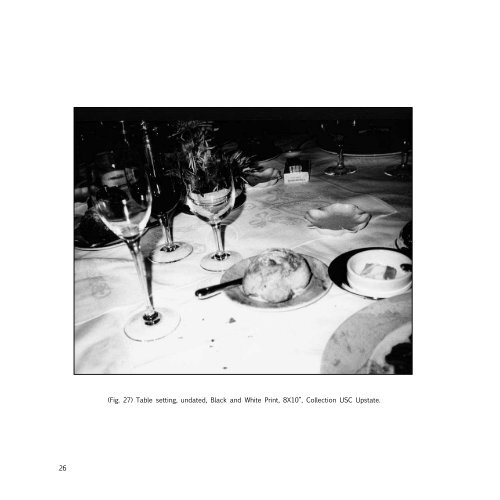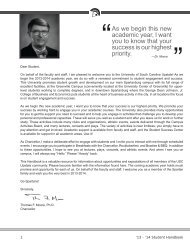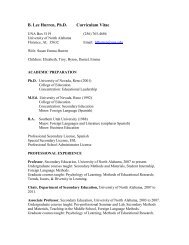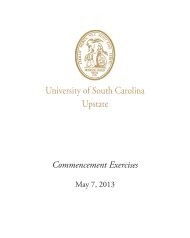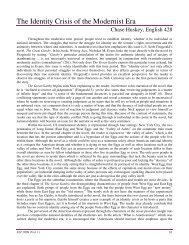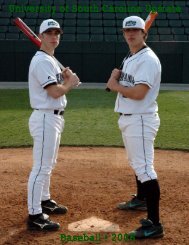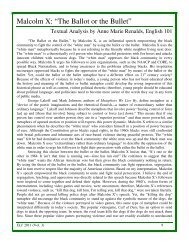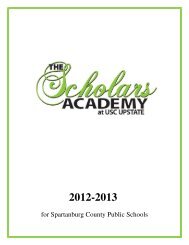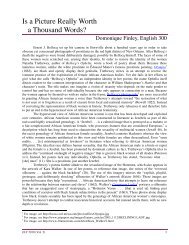The Andy Warhol Photographic - University of South Carolina Upstate
The Andy Warhol Photographic - University of South Carolina Upstate
The Andy Warhol Photographic - University of South Carolina Upstate
Create successful ePaper yourself
Turn your PDF publications into a flip-book with our unique Google optimized e-Paper software.
<strong>Warhol</strong> In and Out <strong>of</strong> the Still Life Tradition<br />
Rachel Snow<br />
Many <strong>of</strong> <strong>Andy</strong> <strong>Warhol</strong>’s photographs, including those acquired in 2008 by the <strong>University</strong><br />
<strong>of</strong> <strong>South</strong> <strong>Carolina</strong> <strong>Upstate</strong> as part <strong>of</strong> the <strong>Andy</strong> <strong>Warhol</strong> <strong>Photographic</strong> Legacy Program, reference<br />
long-standing art historical genres. <strong>The</strong> collection primarily features portraiture, but it also includes<br />
nudes and still lifes. This essay focuses on the last category to discover the ways that<br />
<strong>Warhol</strong> both relies upon and subverts conventions <strong>of</strong> the still life genre.<br />
<strong>Warhol</strong>’s black and white photograph <strong>of</strong> a formally set dinner table is perhaps the most<br />
traditional still life in the USC <strong>Upstate</strong> collection (Fig. 27). An uneaten roll on a small porcelain<br />
plate comprises the image’s focal point. It is located in the brightest part <strong>of</strong> the photograph and<br />
there are no objects obscuring it. A pack <strong>of</strong> Chesterfield cigarettes appears directly behind the<br />
plate, helping to create a clear diagonal line leading the viewer’s eye into the background. <strong>The</strong><br />
scene’s tight framing highlights the artist’s presence but also leaves enough room to suggest<br />
that a spot has been left for the viewer at the table. <strong>The</strong>se are compositional devices seen<br />
again and again in the still life genre. As with many images in the USC <strong>Upstate</strong> collection, it can<br />
be hard to tell if <strong>Warhol</strong> actively composed this scene into the still life that he wanted, or if he<br />
found, framed and preserved an authentic moment with his camera. Whether through recognition<br />
and appropriation or through active manipulation <strong>of</strong> the objects present at the time <strong>of</strong> creation,<br />
works like this demonstrate that <strong>Warhol</strong> was using visual tropes from the still life tradition.<br />
(Fig. 27) Table setting, undated, Black and White Print, 8X10”, Collection USC <strong>Upstate</strong>.<br />
In her essay “Objects <strong>of</strong> Desire: the Modern Still Life,” curator Margit Rowell suggests that,<br />
“Throughout history the still life has been defined as a composition <strong>of</strong> inanimate (usually domestic)<br />
objects, and it is this fundamental limitation that has allowed, indeed obliged, artists to exhibit a<br />
high degree <strong>of</strong> imagination and invention in order to achieve true originality in the genre.” 1<br />
1 Margit Rowell, “Objects <strong>of</strong> Desire: <strong>The</strong> Modern Still Life,” MoMa 25 (Summer 1997): 2. Rowell provides a more indepth<br />
examination <strong>of</strong> the still life genre in the exhibition catalog, Margit Rowell, Objects <strong>of</strong> Desire: <strong>The</strong> Modern Still<br />
Life, (New York: Museum <strong>of</strong> Modern Art, 1997).<br />
26<br />
27


